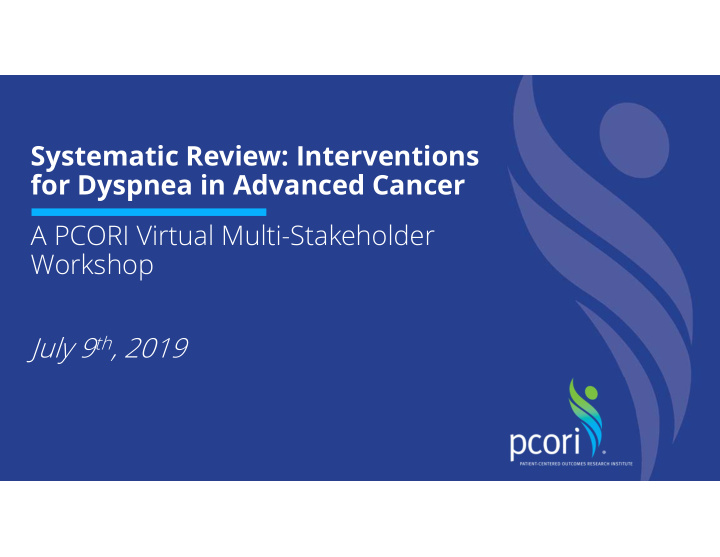



Systematic Review: Interventions for Dyspnea in Advanced Cancer A PCORI Virtual Multi-Stakeholder Workshop July 9 th , 2019
Welcome! Today’s PCORI Representatives: Bill Lawrence, MD, MS, Senior Clinical Advisor, Office of the Chief Engagement and • Dissemination Officer, PCORI Ellen Kimmel, MLIS, Program Officer, Office of the Chief Science Officer, Research Synthesis, • PCORI Michelle Althuis, PhD, MA, Program Officer, Research Synthesis, Office of the Chief Science • Officer, PCORI 2
Housekeeping Participants’ lines are live • • Please mute your line when you are not speaking to reduce background noise Today’s conversation is being recorded and will be posted to the PCORI website • We will take stakeholder comments in the order indicated • If you wish to speak during the open comments/questions period, please • indicate this by typing “permission to speak” in the chat box Comments and questions from participants may be submitted via the chat • window • We cannot guarantee a question will be addressed 3
Agenda
Agenda • Welcome • Background and goals for the webinar: • Background • Proposed Systematic Review Key Questions (KQs) • PICOTS • Moderated discussion • Summary and closing remarks • Adjourn 5
Background
Background and Goals • Goals for the Systematic Review: • To provide evidence for a new clinical practice guideline developed by the American Society of Clinical Oncology (ASCO). • PCORI is commissioning, via the Agency for Healthcare Research and Quality (AHRQ), a systematic evidence review of pharmacological and non-pharmacological interventions for the management of dyspnea in adults with advanced cancer. • Goal for this webinar: to receive stakeholder input on the Key Questions for this Systematic Review. 7
Proposed Systematic Review Key Questions
Key Question One: What are the benefits of pharmacological interventions (either alone or in combination) for improving dyspnea in advanced cancer patients, and how do they compare with each other? PICOTS framework Population Advanced cancer patients w/ cancer ‐ associated dyspnea ≥ 18 yr Intervention Pharma : Opioids, phenothiazines, anxiolytics, corticosteroids, bronchodilators, lidocaine, antiprostaglandins Comparator Placebo, usual care, other pharma intervention or a combination of pharma interventions Outcomes Dyspnea, anxiety, QoL, functional capacity Timing No limit on study length Setting Hospital, outpatient palliative care clinic, oncology clinic, home health care, hospice care Study design Randomized clinical trials 9
Key Question Two: What are the benefits of non-pharmacological interventions (either alone or in combination) for improving dyspnea in advanced cancer patients, and how do they compare with each other? PICOTS framework Population Advanced cancer patients w/ cancer ‐ associated dyspnea ≥ 18 yr Intervention Non ‐ pharma: walking/mobility aids, fan therapy, behavioral interventions, exercise, respiratory training, oxygen therapy, acupuncture, neuromuscular electrical stimulation, changing the room environment Comparator Placebo, usual care, other non ‐ pharma intervention or a combination of non ‐ pharma interventions Outcomes Dyspnea, anxiety, QoL, functional capacity Timing No limit on study length Setting Hospital, outpatient palliative care clinic, oncology clinic, home health care, hospice care Study design Randomized clinical trials 10
Key Question three: What are the comparative benefits of pharmacological interventions as compared to, or in combination with non-pharmacological interventions, for improving dyspnea in advanced cancer patients? PICOTS framework Population Advanced cancer patients w/ cancer ‐ associated dyspnea ≥ 18 yr Intervention Pharma : Opioids, phenothiazines, anxiolytics, corticosteroids, bronchodilators, lidocaine, antiprostaglandins Comparator Placebo, usual care, other non ‐ pharma intervention or a combination of non ‐ pharma interventions, or combinations of pharma and non ‐ pharma interventions Outcomes Dyspnea, anxiety, QoL, functional capacity Timing No limit on study length Setting Hospital, outpatient palliative care clinic, oncology clinic, home health care, hospice care Study design Randomized clinical trials 11
Key Question Four: What are the harms of pharmacological and non-pharmacological interventions for improving dyspnea in advanced cancer patients? PICOTS framework Population Advanced cancer patients w/ cancer ‐ associated dyspnea ≥ 18 yr Intervention Pharma : Opioids, phenothiazines, anxiolytics, corticosteroids, bronchodilators, lidocaine, antiprostaglandins Non ‐ pharma: walking/mobility aids, fan therapy, behavioral interventions, exercise, respiratory training, oxygen therapy, acupuncture, neuromuscular electrical stimulation, changing the room environment Comparator Pharma or non ‐ pharma interventions listed above Outcomes Dizziness, drowsiness, headache, constipation, nausea, vomitting, urinary retention, death Timing No limit on study length Setting Hospital, outpatient palliative care clinic, oncology clinic, home health care, hospice care Study design Randomized clinical trials, prospective and retrospective cohorts 12
Moderated Discussion Moderator: Bill Lawrence, MD, MS
Order of Comments • American Society of Clinical Oncology (ASCO) • Dana-Farber Cancer Institute • American College of Physicians (ACP) 14
Order of Comments Representatives • American Society of Clinical American College of Physicians • (ACP) Oncology (ASCO) Banu E. Symington, MD, • Eric Roeland, MD, Palliative • MACP, Medical Director, Care and Medical Oncology Sweetwater Regional Cancer Physician, Massachusetts Center General Hospital • Dana-Farber Cancer Institute • Janet Abrahm, MD, Professor of Medicine, Harvard Medical School, Department of Psychosocial Oncology and Palliative Care 15
Key Questions 1. What are the benefits of pharmacological interventions (either alone or in combination) for improving dyspnea in advanced cancer patients, and how do they compare with each other? 2. What are the benefits of non-pharmacological interventions (either alone or in combination) for improving dyspnea in advanced cancer patients, and how do they compare with each other? 3. What are the comparative benefits of pharmacological interventions as compared to, or in combination with non-pharmacological interventions, for improving dyspnea in advanced cancer patients? 4. What are the harms of pharmacological and non-pharmacological interventions for improving dyspnea in advanced cancer patients? 16
Open Comments and Questions Period
Summary and Closing Remarks
Contact Information Sarah Stothers, RN, MSN, MPH, Senior Program Associate @pcori 202.827.7700 /PCORInstitute sstothers@pcori.org PCORI www.pcori.org /pcori 19
Thank you!
Recommend
More recommend